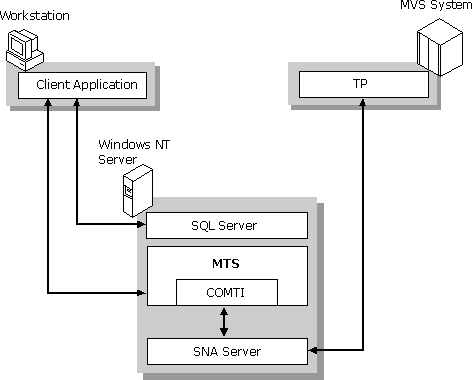
As SNA networks are integrated with PC-based local area networks, many organizations are investigating ways to leverage the power of host systems to run new client/server applications accessible from the PC. One method uses COM Transaction Integrator for CICS and IMS.
COM Transaction Integrator simplifies the process of creating applications that consist of Automation clients running on the desktop or server with COBOL servers running under CICS or IMS. Any application or development platforms that support Distributed COM (DCOM) and Automation can use COM Transaction Integrator components. For example, an application written in Visual Basic (VB), Visual Basic for Applications (VBA), or VBScript, could provide access to host data from within Microsoft Excel. This feature can also be used through Web browsers that connect to Microsoft Internet Information Server (IIS).
Applications that run in part on Windows platforms and in part on the mainframe are distributed applications. COM Transaction Integrator supports all distributed applications that adhere to the Automation and Distributed COM (DCOM) specifications, although not all parts of the application have to adhere to these standards.
COM Transaction Integrator is composed of three parts:
COM Transaction Integrator directly supports any transaction program (TP) that executes in CICS and is structured to use either distributed program linking or Advanced Program-to-Program Communication (APPC) verbs. It also directly supports IMS applications that are structured to use the IMS Message Queue. Because the feature can access CICS programs, developers can extend the client application calls even further by using CICS to access any other program on an MVS mainframe, such as DB2.
Figure 10.1 shows how SNA Server can be integrated with a host application. A client application uses the COM Transaction Integrator (COMTI) feature hosted by Microsoft Transaction Server (MTS) to access a TP running on the mainframe. The specific TPs supported by the feature are IBM's Customer Information Control System (CICS) and IBM’s Information Management System (IMS). An example of this type of distributed application might be reading a DB2 database on the mainframe to update data in a SQL Server database on Windows NT Server.

Figure 10.1 Integrating SNA Server with a host application.
The client components can run on any platform that supports DCOM, including:
Because DCOM is language-independent, developers can build their client applications using the languages and tools with which they are most familiar. Common client/server application development environments include:
Once created, the client components can make calls to the COM Transaction Integrator Automation object (or any other Automation object) registered on the Windows NT Server.